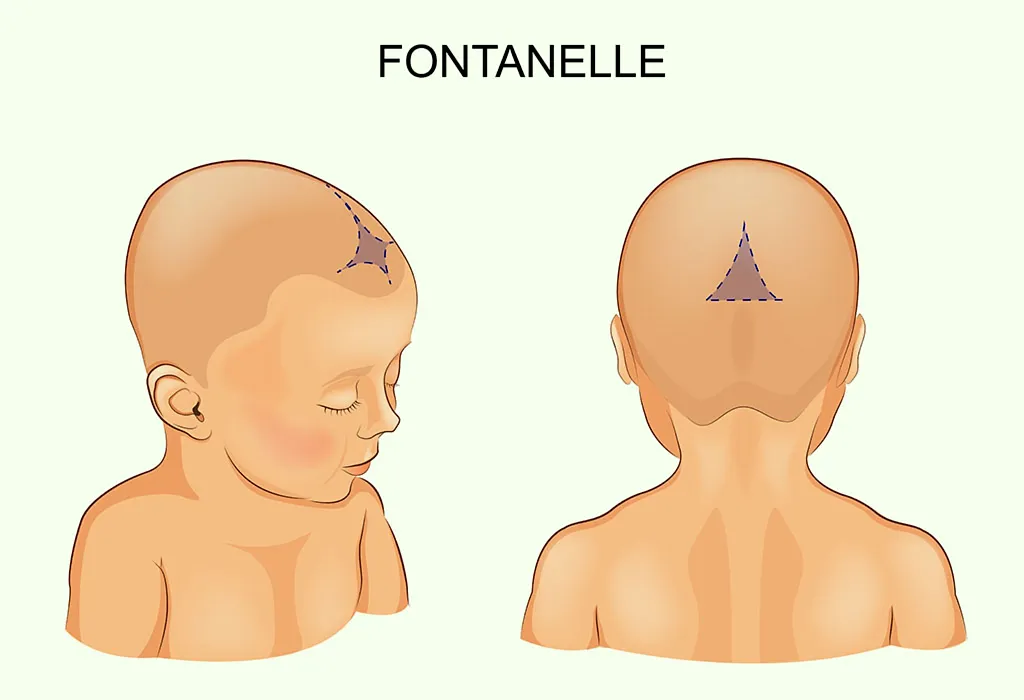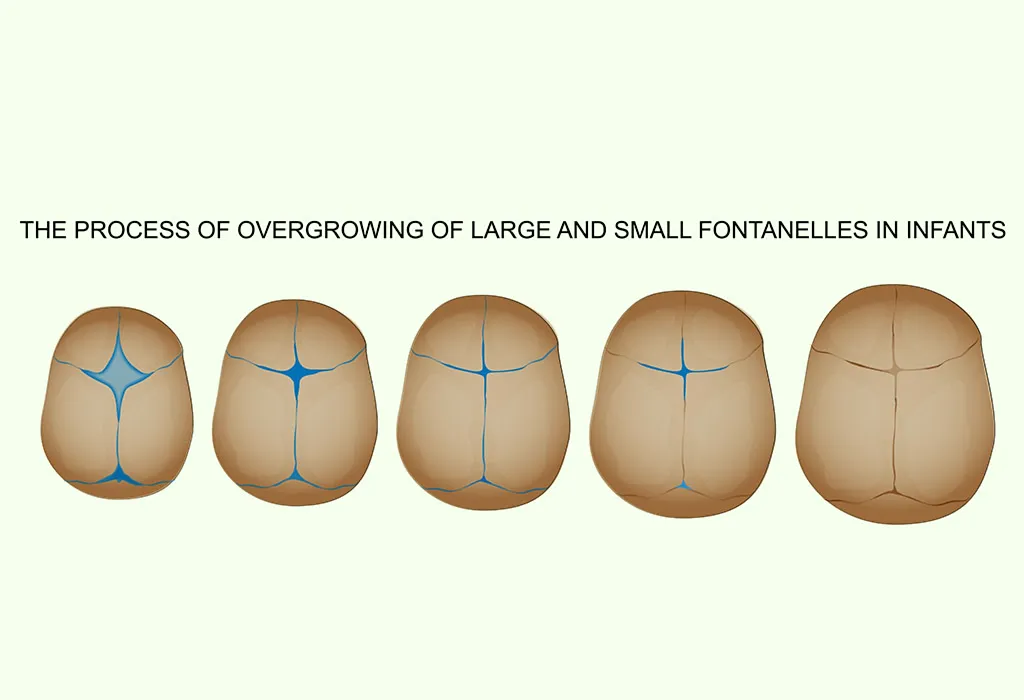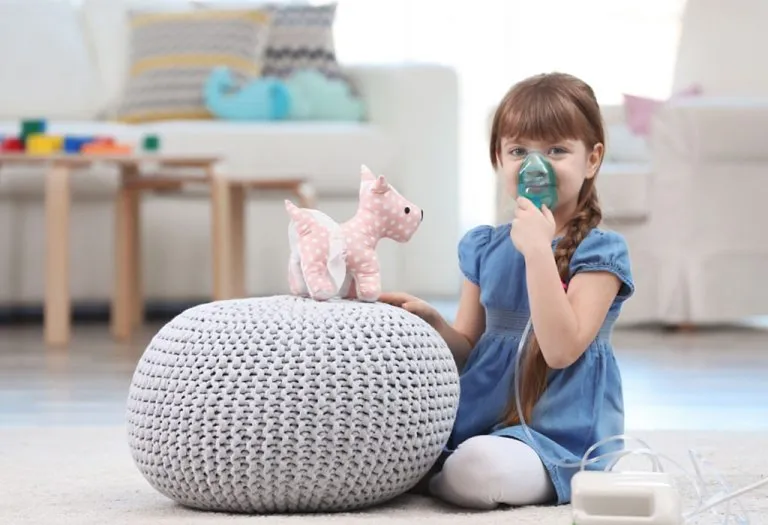Soft Spot on a Baby’s Head (Fontanelle)

The skull is one of the most important bones of the human body and one of the strongest too – a necessity, considering that it shields the brain, the most important organ in the human body. However, if you’ve noticed a newborn baby’s head, you’ll see that the head is relatively soft, so much so that they have soft spots (usually two of them) on their scalp. These soft spots found are called fontanelles. While this may seem bizarre, the fact is that your baby’s soft head is nature’s way of aiding a safe and easy delivery during childbirth. This article will provide you with all the relevant details you need to know about the soft spots on your baby’s head. Read on to know more.
What Are Fontanelles or Soft Spots on the Skull in Infants?
Here’s the definition of a soft spot. The head is the biggest part of a newborn baby. In spite of that, the baby can pass through the birth canal during delivery. What allows this smooth passage is a process called moulding during which the fontanelles or the soft spots on the baby’s head get moulded to reduce the size of the baby’s head (1). The infant soft spots eventually close once the bones of the skull join together and take shape as the baby grows.
Types of Soft Spots on Baby’s Head
Babies are born with soft spots, known as fontanelles, on their heads. These areas are gaps between the bones of the skull that allow for growth and flexibility during birth and early development. Understanding the types of soft spots and their purpose can help parents and caregivers monitor their baby’s health and development (2).
1. Anterior Fontanelle
The anterior fontanelle is the most prominent soft spot, located at the top of the baby’s head. It is diamond-shaped and typically closes between 12 to 18 months of age. This soft spot allows for rapid brain growth during the first year of life.
2. Posterior Fontanelle
The posterior fontanelle is smaller and triangular, situated at the back of the baby’s head. It usually closes much earlier, around 2 to 3 months after birth. This spot is less noticeable but equally important for skull flexibility during delivery.
3. Sphenoid Fontanelle
The sphenoid fontanelle is a smaller soft spot located near the temple, on the side of the baby’s head. It is less prominent than the anterior and posterior fontanelles and typically closes within the first few months of life.
4. Mastoid Fontanelle
The mastoid fontanelle is another small soft spot located behind the ear. Like the sphenoid fontanelle, it is less noticeable and closes early, usually within the first few months after birth.
Where Are the Soft Spots Found on the Head?
The soft spots or the fontanelles are found on the top and the back of the baby’s head. These are, therefore, also called anterior and posterior fontanelles.
The anterior fontanelle is soft, almost fleshy, and on the top of the head. The anterior fontanelle usually closes sometime between 7 months and 18 months. The posterior fontanelle is a little less obvious as opposed to the anterior fontanelle. It is at the base of the baby’s head and may already be closed at birth. The fontanelles of the skull disappear as the head develops and the skull is formed completely (3).
Why Do Babies Have Soft Spots on Their Heads?
A soft spot on the baby’s skull enables easy passage of the baby during labour. The presence of soft spots on the head could also indicate health issues or medical complication that the baby could have.
Is It Normal If the Soft Spots Look Different Than Usual?
There is a possibility that the soft spot on your baby’s head will look different than usual. If the soft spot is slightly indented, it is an indication that the baby is dehydrated. If the indentation is too much, it could indicate malnutrition (4).
A large or wide fontanelle is usually seen in premature babies. However, if you think that the soft spot is too large, you must consult your doctor at the earliest as it can be a sign of complications like meningitis, encephalitis or other health issues.
Also, in rare cases, this may indicate swelling in the brain, which can be a cause of concern if it is accompanied by fever or lethargy. The reasons for swelling in the brain are not limited to head injuries only. So, ensure you get a complete diagnosis done if your baby’s fontanelles seem enlarged.
Other than the visual appearance, closure of fontanelles should also be checked as there are complications that could arise if the spot spots close before or after the estimated time. Read on to know more.
When Do Fontanelles Close or Go Away?
Fontanelles, or soft spots on a baby’s head, close at different stages: the posterior fontanelle typically closes by 2 to 3 months, the sphenoid and mastoid fontanelles by 6 months, and the anterior fontanelle, the largest and most noticeable, usually closes between 7 to 18 months, though it can vary (5). Factors like genetics, nutrition, and medical conditions can influence the timing. If fontanelles close too early, too late, or appear sunken or bulging, it may indicate a health concern, and a pediatrician should be consulted. Monitoring their closure is an important part of ensuring healthy development.
What Happens If You Touch Your Baby’s Fontanelle?
Touching your baby’s fontanelle gently is safe and won’t harm them, as it is protected by a tough membrane. Light touches during activities like washing their hair are fine, but avoid applying pressure or poking the area. The fontanelle may pulsate slightly, which is normal, but be cautious to prevent accidental bumps. If you notice abnormalities like bulging (which could indicate increased intracranial pressure) or sunken areas (a possible sign of dehydration), contact your pediatrician. Handling the fontanelle with care allows you to monitor your baby’s health while keeping them safe.
What If It Takes Longer for the Closure of Fontanelles?
The anterior soft spot closes at an average of eighteen weeks, while the posterior fontanelle closes at about six to eight weeks. A delay in the closure of the baby’s soft spot is an indication of disorders like dwarfism, metabolic issues, hydrocephalus and Down’s syndrome (6). You must talk to a paediatrician when the fontanelles do not close after a stipulated time.
What If a Soft Spot Closes Too Soon?
Premature closure of fontanelles can lead to complications as well. The pressure in the head increases if the soft spots close too soon and could lead to craniosynostosis, wherein the baby will have an abnormal skull development (7). This is evident from the unusual shape of the head. You must consult the paediatrician and seek immediate medical guidance if you see signs of craniosynostosis in your baby.
You are now probably wondering if there are treatments available for abnormalities diagnosed in fontanelles. Let’s find out if there are.
Treatment Options for Abnormalities in the Fontanelles
The medical practitioner could prescribe certain treatments for the following conditions:
1. For Sunken or Indented Fontanelles
A sunken soft spot in the head is an indication of dehydration. The baby will need to be fed enough liquids to treat this condition. In case the paediatrician has diagnosed malnutrition, the baby’s diet will need to be looked at to provide him/her complete nourishment.
2. For Craniosynostosis
If this birth defect is not as severe, the paediatrician would recommend a cranial mould to reshape the skull and allow the brain to develop normally. However, in the case of severe craniosynostosis, the doctor might recommend a correctional surgery, which could relieve some pressure on the head and improve the symmetry of the head (8). This treatment will also bring about improvement in the appearance of the head.
What Precautions Do You Need to Take While Handling a Newborn?
There is so much more to handling a baby than just feeding and changing diapers. The one thing that every adult has to remember is to be gentle. This holds true, especially while handling the baby’s head.
A newborn’s head continues to develop up to about a year after his birth. The skull is not well developed and formed yet, and while the fontanelles of a newborn have tissues that cover the brain, it is still imperative that you handle the head with care.
Make sure your baby’s head is covered, especially during the winter and if it’s cold. A gentle head massage during bathtime will help form the bones too. Also, ensure you check the baby’s head for any signs or indications of abnormalities or complications. Usually, the appearance of the soft spots indicates the underlying issue, which is explained below.
When to Consult the Doctor
A baby’s fontanelles, or soft spots, are important indicators of their health and development. While they typically close on their own as the skull bones grow, certain signs may require medical attention. Knowing when to consult a doctor can help ensure your baby’s well-being.
- Bulging Fontanelle: If the soft spot appears swollen or bulging, it could indicate increased intracranial pressure, possibly due to conditions like meningitis or hydrocephalus.
- Sunken Fontanelle: A sunken soft spot may be a sign of dehydration or malnutrition, especially if accompanied by other symptoms like dry mouth or reduced urination.
- Delayed or Early Closure: If the fontanelles close too early (before 9 months) or too late (after 18 months), it may signal developmental issues like craniosynostosis or nutritional deficiencies.
- Unusual Changes: If you notice redness, tenderness, or discharge around the fontanelle, it could indicate an infection or other underlying condition.
FAQs
1. Can a baby’s fontanelle reopen after closing?
In rare cases, a fontanelle may appear to reopen due to conditions like severe malnutrition, dehydration, or increased intracranial pressure. This is not normal and requires immediate medical evaluation to address the underlying cause.
2. Why does my baby’s fontanelle pulsate?
A pulsating fontanelle is normal and occurs due to the blood flow in the vessels beneath the soft spot. It reflects the baby’s heartbeat and is not a cause for concern unless accompanied by other symptoms like bulging or fever.
3. Is it safe to use a baby carrier or swaddle with a fontanelle?
Yes, it is safe to use baby carriers or swaddles as long as the baby’s head is properly supported and there is no excessive pressure on the fontanelle. Always ensure the baby’s head is in a neutral position to avoid strain on the soft spot.
The soft spot on your baby’s head is nature’s way of helping the newborn make its way through the birth canal, but that’s not all there is to it. The fontanelles can help indicate underlying disorders or complications that the child is likely to suffer. So make sure you’re completely observant when it comes to your baby’s skull and the soft spots on his/her head.
References/Resources:
1. What To Know About Baby’s Fontanelles (aka Soft Spots); Cleveland Clinic; https://health.clevelandclinic.org/fontanelle-baby-soft-spot
2. Lipsett. B, Reddy. V, Steanson. K; Anatomy, Head and Neck: Fontanelles; National Library of Medicine; https://www.ncbi.nlm.nih.gov/books/NBK542197/
3. Your Baby’s Head; American Academy of Pediatrics; https://www.healthychildren.org/English/ages-stages/baby/Pages/Your-Babys-Head.aspx
4. Fontanelles – sunken; Mount Sinai; https://www.mountsinai.org/health-library/symptoms/fontanelles-sunken
5. Anterior and Posterior Fontanelle Closures; Children’s Hospital Colorado; https://www.childrenscolorado.org/just-ask-childrens/articles/fontanelles/
6. Kiesler. J, Ricer. R; The Abnormal Fontanel; American Family Physician; https://www.aafp.org/pubs/afp/issues/2003/0615/p2547.html; June 2003
7. Craniosynostosis; CDC; https://www.cdc.gov/birth-defects/about/craniosynostosis.html
8. Uneven Head Shape in Babies: Causes and Treatment of Craniosynostosis; American Academy of Pediatrics; https://www.healthychildren.org/English/health-issues/conditions/Cleft-Craniofacial/Pages/Uneven-Head-Shape-Craniosynostosis.aspx
Also Read:
Baby’s Head Shape
Baby’s Head Engaged
Baby’s Soft Spot(Sunken Fontanelles)
Was This Article Helpful?
Parenting is a huge responsibility, for you as a caregiver, but also for us as a parenting content platform. We understand that and take our responsibility of creating credible content seriously. FirstCry Parenting articles are written and published only after extensive research using factually sound references to deliver quality content that is accurate, validated by experts, and completely reliable. To understand how we go about creating content that is credible, read our editorial policy here.

























